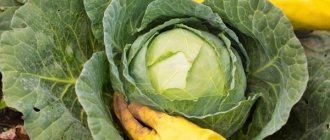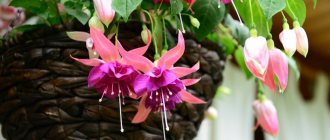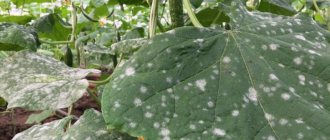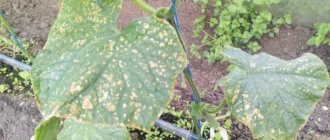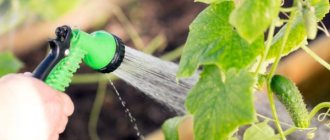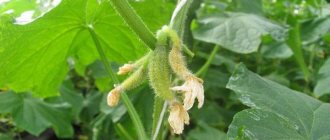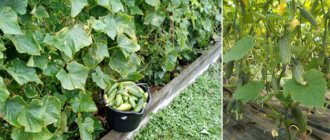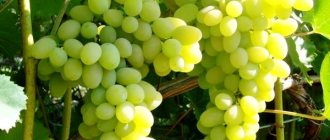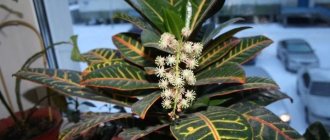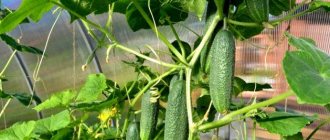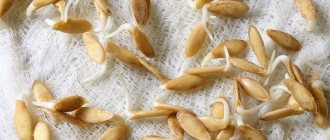Is it possible to trim leaves from cucumbers and how to do it correctly
It’s hard to imagine a summer cottage without a neat bed of cucumbers.
However, growing this crop raises a number of questions for beginning gardeners. In particular, do cucumbers need leaf pruning? Is it worth forming a vine? In the article you will find detailed answers to these questions. We will tell you whether it is possible to trim the leaves of cucumbers for better fruiting, at what time and how to do it correctly. After learning the specifics of care and reading our recommendations, you will decide for yourself whether it is worth pruning cucumbers.
How to shape cucumbers correctly?
It is important to correctly form cucumbers; for this you must follow some rules:
- You need to pick barren flowers in time;
- the instrument must be sharp and disinfected;
- It is better to carry out the shaping in the morning (the wounds can heal over the whole day);
- work carefully with the central upper branches; if damaged, the bush may completely die;
- the leaves of the bottom row are removed;
- You need to pick dry leaves, damaged branches and bad fruits from the bush;
- Stumps should not be left after cutting, as this increases the likelihood of fungal infections.
The formation procedure in a polycarbonate greenhouse is carried out regularly, with an interval of 7 days or even more often.
The formation procedure begins with tying the bush to a support. There are three ways to properly tie:
With the horizontal method, two wooden or metal pegs are installed in the ground on both sides of the bed (it is important that they are high). A rope is pulled between them. If vertical formation is assumed, then the rope between the stakes is pulled at the very top
From it, a piece of fabric is passed to each bush, along which the cucumber lashes will climb up. There is also a combined version of the garter. In this case, a net is installed near the bed, along which the lashes cling with their antennae.
Stepping is carried out by observing a number of sequential actions indicated in the instructions:
- the side lashes begin to be removed from the bottom of the stem up to the 5th leaf;
- at a height of 85 cm, two shoots should be left (their length is reduced to 20 cm) with two leaves;
- starting from a stem height of 125 cm, the length of the side branches should not exceed 40 cm (2 leaves and two ovaries are left on them);
- at a height of 155 cm, 4 leaves and the same number of ovaries are left on the shoots;
- then the top is pinched.
All these actions will allow you to form a neat, productive bush. As a result, free access of air and light to all parts of the plant will be ensured. The greens will be sweet, crisp and smooth.
Parthenocarpic varieties
Parthenocarpic (self-pollinating) hybrid varieties of cucumbers do not require pollination by insects, since only female inflorescences are formed. Most of the inflorescences are located on the main stem, so all efforts should be directed towards its formation.
Self-pollinating varieties of cucumbers quickly gain green mass. Pruning begins 3 weeks after planting in the greenhouse. By this time, 5-6 true leaves should appear, and the height of the bush will reach 35 cm.
The bush formation scheme is simple:
- In the axils of the first five leaves of the lower row, flowers and ovaries must be removed.
- Then you need to leave 6 shoots. They are shortened, leaving a length of 25 cm. One leaf is left on each branch and the shoots are removed.
- Pinching begins from the 9th shoot. Leave 2 leaves and two ovaries. The length of the shoots should be approximately 45 cm.
- As soon as the bush reaches the height of the installed support, the top is directed downwards and cut off.
Bee-pollinated varieties
Bee-pollinated cucumber varieties will not form ovaries without pollination. Cucumber varieties that are pollinated by bees should be formed a little differently. The difference between the varieties of this group of vegetables lies in the peculiarities of the formation of ovaries and fruits on the side branches. In most cases, male inflorescences and barren flowers appear on the main stem. Therefore, it is better to form 2 or three stems.
These varieties are more suitable for growing in open garden beds, but if properly formed, it is quite possible to grow them in a greenhouse.
Step-by-step instructions will allow you to carry out the procedure correctly:
- the central stem is not pinched until it reaches a high point;
- in the axils of the 5 lower leaves, remove the stepsons, ovaries and flowers;
- in the next two axils, only the buds of the lateral branches are removed;
- then the side branches of two levels are pinched, leaving a length of 20 cm;
- the next shoots are shortened so that their length remains 40 cm;
- closer to the top of the main stem, the length of the branches should be 52 cm;
- The top of the bush is directed down and pinched.
If you form cucumbers correctly, following all the recommendations, you will be able to grow a good harvest.
https://izbavsa.ru/ogorod/kak-pravilno-obrezat-ogurcy-teplice
https://dachamechty.ru/ogurtsy/obrezka-v-teplitse-shema.html
https://moefermerstvo.ru/ogurtsy/formirovanie-v-teplitse
Is it possible to trim leaves from cucumbers?
Trimming leaves is not only possible, but necessary. Let's look at why cucumber leaves are trimmed, and which ones exactly.
Cucumbers belong to the liana-like shrubs. They form a long vine on which the fruits are located. If the vine is not pruned, the green mass, actively growing, will take all the strength from the plant. Fruiting in this case will be weak.
Is it possible to trim the bottom/top leaves?
The formation of the vine occurs by removing the lower leaves, side shoots and barren flowers. To prevent root rot, pruning is carried out in the first part of the vine. Remove all inflorescences, side shoots, yellowed leaves and leaves touching the ground.
This pruning provides ventilation and also allows the plant to direct nutrients to the fruiting zone. For hybrids, the entire upper part is removed, starting from the sixth leaf. Three subsequent side shoots are left for fruiting.
During harvesting, the upper leaves are not cut off, as they play an important role in the formation of the fruit.
Important ! Tearing off the top leaves of varietal crops (not hybrids) leads to yellowing of cucumbers.
Why do this
Many gardeners are not sure whether to trim the leaves of cucumbers. Let's look together at what this method does:
- Saves water and nutrient consumption.
- Prevents the spread of infections and pests.
- Accelerates fruit ripening.
- Increases the formation of female inflorescences.
Why is the procedure needed?
The technical technique improves the yield and quality of vegetables. A kind of management practice that helps control the uncontrolled growth of a plant. Removing damaged leaves or excess shoots helps ensure adequate nutrition to allow vigorous fruit production. Eliminating unnecessary elements minimizes shading and maximizes sunlight penetration, which increases photosynthesis, improving crop yields. This eliminates the possibility of pests that cause disease in poorly ventilated bushes.
Planting an apple tree in the Moscow region in autumn: diagram and care, video and photo
Cucumbers are very susceptible to diseases, which requires special control over the plants. By avoiding the appearance of excessive foliage, it is easy to monitor the development of cucumbers. However, plucking should be avoided, which could potentially reduce yield. Finally, moderate pruning will allow for easy harvesting.
Advantages and Disadvantages of Leaf Trimming
Benefits of pruning:
- the beds are ventilated from all sides;
- sunlight penetrates all parts of the vine;
- bees will be able to pollinate more inflorescences;
- plants are less susceptible to root rot;
- Cucumbers bear fruit longer.
There are practically no disadvantages in pruning leaves, provided that crop care technologies are followed.
Important! Excessive pruning of leaves in hot weather can harm the plant. Direct rays of the sun negatively affect fruiting.
Trimming procedure
We have already figured out whether it is possible to pick off foliage and when is the best time to do it. Let's move on to the technology of trimming vegetables in a greenhouse.
You can trim leaves effectively by using general pruning and lightening pruning. Generally recommended for self-pollinating varieties, of which the majority are. Lightening is relevant when dealing with weakened and diseased crops.
It is recommended to divide the scourge into 4 zones. First of all, remove the flower primordia and side shoots from leaves 2 to 4. In zone 2, where there are 3–4 nodes, 1 cucumber and 1–2 leaves are left on the side shoots, and the growing point is discarded. In zone 3, where the plant height is 1–1.5 meters, at 3–4 nodes, 2 fruits and 2 leaves are left untouched. In zone 4, the highest part of the stem, leave 3 cucumbers and 3 leaves.
As the central stem grows to the wire, it is wrapped around it several times, and after 4 leaves the growth point is removed. The whip is tied to the trellis using twine. The first shoot that grows from the axil of 1 leaf should be pruned. The three shoots that appear after this are distributed along the wire in a checkerboard pattern - 2 to the left and 1 to the right. This is how it is possible to achieve better illumination of culture. As they grow, it will be correct to pinch off the lashes every 0.5 m as they grow. The new shoot will be a continuation of the lash. All shoots need to be pinched when massive fruit ripening is observed. Their growth should be directed downward. This applies to general pruning.
Lightening pruning involves removing side shoots and wilted leaves that point downwards. This is done in any area of their location. The excess ovary is also removed. As a result of the manipulations, 6 ovary nodes and a few leaves should remain. Your crops will receive enough light and air to grow properly. If a side shoot is visible near the ground from 1 node, it does not need to be torn off, but it would be correct to place it on the soil along the fence.
Types of pruning
The peculiarity of cucumbers is that they have female and male inflorescences.
The male ones grow on the main stem and do not produce fruit. They are called "barren flowers". To increase the yield, such inflorescences are pinched. The leaves are not torn off, since the plant absorbs nutrients through them.
Female inflorescences grow on side shoots. From them fruits are formed.
Let's look at which leaves to remove from cucumbers to increase the yield and how to do it.
There are two ways to prune cucumbers: general and lightening. Let's look at each of them, find out which varieties and how to trim them.
General
This type of pruning is used for self-pollinating cucumbers. Such crops produce a bountiful harvest and require pruning. The fruits are formed on the main stem, which can support a large harvest. Some fruits are also left on the side shoots to grow.
Important! In hybrid varieties, the harvest is formed mainly on the main stem.
The cucumber vine is conventionally divided into four parts:
- The first is the lower part of the whip near the ground.
- The second is the next meter (four growth nodes).
- The third is the next half meter of the whip.
- The fourth is the top of the bush.
How to prune cucumbers:
- At the bottom of the lash, all inflorescences, barren flowers, side shoots, yellow and drooping leaves are removed.
- Pinch off the top part after the sixth leaf to develop side shoots.
- In the second part of the vine's growth, three main sprouts are left 0.5-1 m from the ground, the rest are removed.
- In the future, they work with these sprouts, leaving four sprouts on them.
Brightening
For weakened and diseased plants, lightening pruning is carried out. It is advisable to reduce the amount of green mass in rainy weather.
Trimming Features:
- remove side shoots;
- remove leaves that darken the vine;
- cut off hanging, limp, yellow leaves;
- Leave 2-3 fruit ovaries.
To increase the yield, in some cases the side stems are left at the first nodes. Side shoots are lowered down to the ground. So the stem stops growing, the fruits begin to actively fill.
Peculiarities of pruning parthenocarpic and bee-pollinated cucumber species
Pruning is also necessary, taking into account the nuances described above. The formation of the bush is carried out as the stem grows. Plant staking is required. And pruning the bush (depending on the conditions of closed ground) can be similar to that used for varieties pollinated by insects.
On a note! Plants of this type usually form a single stem, on which barren flowers, male flowers, first appear.
The ovary and fruits are formed from female flowers, which are placed on the side shoots. To increase their number (and, accordingly, the yield), pinching should be done over 4-5 nodes.
How to prune correctly
Correct and timely pruning will help you grow a bountiful harvest and enjoy fresh cucumbers until late autumn.
Let's look at how to properly trim cucumbers in open ground:
- The procedure is carried out in the evening.
- After pruning, it is recommended to water and fertilize the cucumbers.
- Pruning is carried out along the entire length of the plant.
- Work begins after the sixth leaf grows. The whip is wrapped around the trellis and the growing point is pinched.
- Remove the side shoots in the first half of the vine, as well as all leaves that look down or are wilted.
- The main stem is pinched after it reaches the top of the trellis. This part of the cucumber tops must be constantly monitored throughout the season. You should not let it grow, so as not to darken the beds.
- Growing shoots in the second and third parts of the vine are placed on trellises.
- For uniform lightening, the shoots are distributed in a checkerboard pattern.
- The lashes are pinched at a distance of 0.5 m.
- After pruning, leave 3-4 ovary nodes and some leaves.
- Shoots extending beyond the row are cut off.
How to prune correctly
It is recommended to start the procedure early in the morning. So that by the evening the wounds will heal. Algorithm of actions:
- Find the main loop. The main vine is the one that does not branch. Go to the base of the plant and examine it.
- Having found all the stepsons growing from the sides, you need to remove them. If left, runners will form, which will significantly reduce the yield.
- It is recommended to destroy 4-6 shoots growing from the base of the main branch upward. All other stepsons growing outside are left to grow.
- It is necessary to repeat the process on the remaining plants, tying the lashes to supporting structures or trellis. It is important to avoid bending or tightening the stems too much, which will cause them to wilt and then die.
- Removing damaged cucumbers. Ripe fruits must be collected in a timely manner to avoid overgrown, huge cucumbers of poor quality.
It is not recommended to remove cucumber leaves when they are too young. This can weaken the cucumber vine. Do not clean up immediately after spraying pesticides to avoid losses. After harvesting and the appearance of a large number of ripe fruits, the frequency of pruning is reduced.
It is not recommended to carry out this procedure in rainy weather, so as not to contribute to the spread of diseases between neighboring crops when the plants come into contact.
Advice from experienced gardeners
We recommend listening to the advice of experienced gardeners - let’s take a closer look at what experienced gardeners say.
Vasily: “I have been using the method of forming a cucumber vine by pruning for a long time. I prefer self-pollinating varieties. I form a crop on one stem, there is always a large number of fruits on it. I also leave a few side shoots, they also have a harvest.”
Tatyana: “I recently learned that you need to trim the leaves of cucumbers, and found out which ones to remove for a good harvest. I started doing this and noticed that pruning helps get rid of root rot. I cut off all the leaves and side shoots of the bottom row. Plants are well ventilated from below. In addition, excess tops do not take away nutrients. The cucumbers are filling faster and there is more ovary.”
How to form cucumbers into one stem - step-by-step diagram
As I already said, we need to find a balance between the amount of green mass and the amount of fruit. But you must always remember that the leaf apparatus of a cucumber greatly influences fruit formation, much more than, for example, that of tomatoes. Having removed all the leaves, I’m afraid you can forget about the harvest. Therefore, leaves should be removed only if they are completely diseased.
First formation scheme:
- In the axils of the first 5 leaves, remove all cucumber ovaries and shoots. Don't be afraid to do it, and don't regret what you've done. By such actions you give the opportunity to form the root apparatus as soon as possible, and this is very useful for the plant. As a compromise, you can leave one cucumber ovary in each sinus, but the stepsons must be removed!
- In the next 5 leaf axils, also remove all the stepsons, but you can leave the flower ovaries. By then the roots will have grown and it will be easier for them to feed the fruits.
- In the next 5 axils, also leave all the ovaries and leave additional stepsons, which will need to be pinched when 1 leaf is formed on them. Subsequently, ovaries will form in the axils of these leaves.
- In the next 5 leaves, leave the ovaries and stepsons, which you will pinch when they have 2 leaves. As a rule, at this time the height of the bush is about 2 meters.
- The next step is to leave stepsons in the next 5 leaves and pinch them with 3 leaves.
- The last step will be pinching the crown. When to do this is at your discretion. This can be done when the crown reaches the roof of the greenhouse, or if your bushes are planted widely, you can bend it a little to the side and pinch it a little later. It's up to you to decide, it makes no difference.
This way you will get a cucumber bush that has the shape of an inverted cone, diverging towards the top.
Subsequent care consists of removing all newly appearing stepsons.
Second formation scheme:
- In the axils of the first 5 leaves, remove all cucumber ovaries and shoots.
- Throughout the entire subsequent growth of the plant, only stepsons are removed, leaving none. Also, as in the first scheme, subsequent care consists of removing all newly appearing stepsons.
With this formation pattern, you will only have one stem with fruit on it. As practice shows, the harvest in this case is even slightly greater than when formed according to the first scheme, and caring for the bush is even easier. How to understand which scheme to form?
And this is the most basic question for all gardeners. There is no definite answer here; it all depends on the variety being grown, on how many ovaries it can form. The fewer ovaries in the axils of a variety, the more stepsons can be left. In this case, I can advise you to plant two identical bushes next to each other and form them according to two patterns. Next year you will know exactly which of them will be better for a given variety.
I would also like to advise you to never approach the issue of forming a bush thoughtlessly, i.e. strictly according to the plan. I just gave a recommendation on how to do this. Always look at the circumstances. The fact is that the plant’s ability to bear fruit in bunches is established at the stage of grain germination, and this, as you yourself understand, happens differently for everyone. And the soil in which you plant seedlings is different for everyone.
So it turns out that the same cucumber variety planted by two different gardeners grows differently. The only thing that should be the same for everyone is the lighting of the bushes. There is no exception here.
conclusions
Now you know whether it is necessary to remove leaves from cucumbers and how to do it correctly. Shaping cucumber vines by pruning helps fight disease and increases yield. The plants are well ventilated, the sun's rays evenly illuminate the leaves and fruits, and insects can easily pollinate the inflorescences.
You also learned how to remove leaves from cucumbers so as not to damage the ovaries or break the vines. By removing the male inflorescences, you will direct the plant’s energy to the growth and ripening of fruits. Carry out pruning carefully using our recommendations and advice.
Basic principles of pruning
How to properly trim cucumbers in a greenhouse? This is the formation of bushes, their formation according to the model required for their good growth and development. To do this correctly, you need:
- know how different varieties are pollinated;
- It’s good to know what kind of cucumbers grow in the greenhouse. The pruning will depend on this (bush or vine).
General rules applicable to all types and varieties
- greenhouse cucumbers and pruning are related concepts;
- pruning should be done no earlier than 10 days after planting, after tying up the bushes;
- do not perform pruning with a dirty tool, as this can cause infection;
- Stumps should not be left;
- You should always remove ovaries and flowers from the bottom of the bush. You need to start from the moment the young bush acquires 5 leaves;
- Unfortunately, the matter will not be limited to just pruning. As the stem grows upward, you will need to carry out this procedure;
- no need to tear off the top of the bush with your hands, use a sharp tool;
- Pruning activities should be carried out in the morning so that in the evening the wounds heal and the bushes do not get infected;
- Dead leaves on old bushes should be removed regularly. Yellow and brown, they can disrupt the movement of juices in the stem;
- Keep in mind that the upper parts of the bushes need a lot of light, so at the top the lashes are not directed along the crossbars, but thrown over them;
- sunlight and regular watering do their job: the foliage grows constantly. Inspection, pruning and garter should be constant;
- varieties pollinated by bees should grow in one stem;
- How do you know if your actions are correct? Look at the formed bush. It should be shaped like an inverted isosceles triangle.
Timing for the formation of cucumber bushes
It is very important to observe the timing of pinching bushes, otherwise they may waste energy on extra shoots and form few ovaries and flowers.
- You can start shaping as soon as the stepsons have already grown to 5 cm. There is no need to worry, this will not harm the bush.
- Don’t be lazy, immediately after planting the seedlings, tie the main stem of the bush to the top crossbar with a rope or twine.
- Do not allow the shoots to harden. It's better to cut them off in advance.
- Has the top grown very long already? Great! Make a loop out of it and tie it to the trellis above.
- The side shoots need to be pinched taking into account the size of your greenhouse.
- You can pick up to 5 leaves from each node. A smaller volume is not effective, and a larger volume can harm the plant.
Is it necessary to pick leaves from cucumbers in a greenhouse?
Pruning cucumbers is considered an important agrotechnical technique when growing vegetables. It is carried out for better and longer fruiting.
There is one more procedure that is needed to increase the quality and quantity of the harvest. The formation of cucumber bushes directly affects their healthy growth and development. Light and air will flow freely to all parts of the plant. The risk of contracting infections is reduced. All micronutrients will be spent not on the development of green tops, but on the growth of a crunchy and sweet cucumber.
There is another argument whether it is necessary to pick off the leaves of cucumbers. Uncontrolled formation of foliage and ovaries leads to increased work of the root system. The fruits will not receive enough nutrients, will grow poorly, become deformed, and will taste bitter.
It is also necessary to remove leaves from cucumbers because a large number of them becomes an obstacle to the free passage of air. The leaves begin to turn yellow, wither, and the taste of the fruit decreases.
Forming bushes in the limited space of a greenhouse allows you to freely approach each bush. You can easily loosen and water the soil, weed and spray.
Tying the stem to a support significantly saves space. This procedure reduces the risk of developing infectious diseases and rot. A ripe, good harvest becomes easy and convenient to harvest.
Timing for pruning cucumbers when grown in greenhouses
Temperature in a greenhouse for cucumbers
It is impossible to determine exact dates indicating dates and months, since they depend on the time of planting, pruning method, variety, and climate. But the main regulator is the growth and development of the vegetative mass (leaves, stems, lateral shoots). Initially, the ovary, leaves and stepsons (no more than 5 cm long) are removed on a 40-50 cm segment of the lash. It is time to cut off the top of the main stem descending down when it is located at a distance of 1 m from the ground surface. The growth points of stepsons are cut off if there are any 3-5 knots.
How to shape cucumbers
Carrying out the procedure on unprotected beds
It is also necessary to prune cucumbers in open ground. If the cucumber bushes are planted too close, it is recommended to leave one main stem and cut off the excess vines. Stepping when using another option involves removing not all branches, but only up to the fourth leaf.
Step-by-step instructions on how to properly pick leaves from cucumbers:
- cucumber lashes are conventionally divided into four equal parts;
- they begin to tear off the leaves along with the side branches located in the axils of the fourth leaf from the bottom;
- in the next part, they continue to remove the side shoots, but one leaf and one ovary should remain;
- in the third conditional zone, cut off all the ovaries and leaves, but as a result there should be two ovaries and two leaves;
- in the last part, three ovaries and leaves are left.
When forming cucumbers in open ground, you need to take into account the fact that male inflorescences are located on the central stem, and female inflorescences are formed on the side vines. Therefore, it is impossible to do without a certain number of side branches and it is important to provide them with the proper conditions.
Excess stepsons must be removed with extreme caution.
How to tie cucumbers in open ground: video and photos
There are several ways to garter cucumbers in open ground: using a net, trellis, arc, horizontal and several unusual devices. For beginning gardeners, we will describe each of them in detail with photos and videos. It may be interesting for experienced summer residents to familiarize themselves with some devices for tying cucumber vines in an open garden bed.
Horizontal garter with photo and video
Beginners in gardening should pay attention to it. The method is very simple and horizontal, it is called because the rope or twine is stretched horizontally between the supports
To make it clearer, we will describe step by step with photos how to tie cucumbers horizontally:
- Metal pipes or wooden supports should be dug along one side of the open bed with a distance of 40-50 cm from each other. They should not wobble.
- Tie a strong twine or rope to one of the outer supports and pull it from pillar to post. The twine is tightly tied to each support.
- You should get several rows of horizontal garter, the first of which is located 10-15 cm from the ground. Otherwise, seedlings with 3-5 true leaves will already begin to fall. A young and still small lash is carefully tied to the bottom rope using a piece of twine under the leaves.
- The second row is tied 25-30 cm from the first and so on.
- To make the structure for the shoots more durable, and for them to have something to cling to, they make a trellis. To do this, tie twine vertically between horizontally stretched ropes.
The disadvantage of this method is that tying requires supports about two meters long. Otherwise, the grown vines of cucumbers will hang down. As a result, they may break or bend. In any case, hanging shoots will shade the lower part of the bushes. But if there are tall metal pipes or fairly thick wooden poles, there will be no problems. Moreover, the design is very simple.
Attention! Monitor the growth of the cucumber vines and point them upward, otherwise they may wrap around the rope and begin to grow vertically.
When growing cucumbers in open ground with horizontal tying, do not pinch the tops of the plants.
Vertical garter: step-by-step instructions with video
To grow a large number of cucumbers in an open garden bed, it is recommended to use the vertical garter method. Experienced gardeners have come up with several methods for tying cucumber vines along vertical supports.
Along simple ropes or twines
You only need two high supports, which are firmly installed along the edges of the bed. A thick twine or rope is stretched between them, to which pieces of twine will be tied and lowered down to the plants. The lower part of the vertical ropes is braided and tied under the leaves of a grown bush. Soon the lashes themselves will wrap around the ropes.
This vertical method of gartering cucumbers is very convenient to use in open ground. But its disadvantage is that the twine stretched at the top bends under the weight of overgrown shoots, and the supports may begin to collapse. Therefore, the foundation of the structure must be strong.
Advice! Look at the photo. A more stable U-shaped structure can be made not from pillars or pipes and rope between them, but from thick long slats. Pieces of twine are tied to the top horizontally attached rail and lowered to the lashes.
VIDEO: TRASH FOR CUCUMBERS IN THE OPEN GROUND WITH YOUR OWN HANDS
Garter on a mesh step by step with video
For gartering cucumbers on an open ridge, it is very convenient to use special nets. They are stretched between supports located on both sides of the ridge. To prevent the mesh from sagging under mature bushes, it is recommended to install a few more small posts at a distance of about a meter and attach them to the mesh.
It is very important to know that you cannot tie cucumber vines to a metal mesh. You can make a mesh with your own hands from twigs or thin slats.. VIDEO OF GRATING CUCUMBERS ON A NET
VIDEO OF GARTERS OF CUCUMBERS ON A NET
Important Rules
Based on the experience of gardeners, whether it is necessary to prune cucumbers, we can say that this procedure is simply necessary. It is important that the top is always in the light. Therefore, the stem must be directed all the time.
Pruning cucumbers in a greenhouse must be carried out in compliance with all rules.
- It is necessary to cut not the entire branch, but only to the growth point, otherwise the entire branch will dry out.
- The procedure for getting rid of leaves from cucumbers in a greenhouse cannot be postponed until later, otherwise the vines will become intertwined and the stem will become thinner.
- Leaves need to be trimmed with special, sharp, sterile garden scissors early in the morning. During the day, the wound will heal and dry out. If the stepsons are broken and torn off manually, the plant will suffer for a long time and the yield will decrease.
- Is it possible to remove the lower leaves of cucumbers? Some vegetable growers advise removing the lower leaves to prevent excessive soil moisture. The risk of spreading fungal infection and root rot is reduced. But you can only pick off the lower leaves of a bush rich in greenery. If the bush has sparse leaves, it can harm the growth and development of the plant.
- It is recommended to pluck off excess mustache, which takes away a lot of nutrients. They cannot be directed horizontally along the trellis, otherwise a shadow will be created.
- Cotyledon leaves should not be removed. These leaves are formed in almost all plants at the very beginning of seedling growth. Cotyledons grow in 7-8 days. This is an elongated single leaf, without a pair. When the plant no longer needs it, the cotyledon leaf itself dries up and falls off.
What leaves should be removed from cucumber bushes? Pick off yellowed, dry leaves. You should not leave those leaves that are covered with spots or pests have settled on them. Such leaves do not allow light to pass through and promote rotting. When is the best time to pick? The procedure is carried out every 7-10 days in the morning.
From reviews of experienced vegetable growers: “Unpruned cucumber vines often begin to turn yellow and curl their leaves. The plant becomes weak, and the fruits begin to ripen later and do not taste as sweet and crunchy. In recent years, I have been making sure to cut off all the side branches with leaves, and I also get rid of diseased, yellow leaves. The harvest pleases with its taste and quantity.”
Do not remove large leaves if they are healthy and rich green in color. Leaves participate in the process of photosynthesis and nourish the entire plant. Large leaves can be a result of an excess of nitrogen or simply because this variety was chosen.
If there are a lot of barren flowers on the bush, there is no need to rush to tear them off. Perhaps by changing the conditions of care, the situation can be improved. Often the cause of the formation of barren flowers is excessive watering and excess nitrogen. Greenhouse soil may also need some microelements.
Basic principles of pruning cucumber bushes in a greenhouse (diagram)
Diseases of cucumbers in a greenhouse
The main purpose of pruning is to shape the bush, which limits the growth of the vegetative mass of the plant in order to supply maximum nutrients to the fruits. In order for pruning to justify the effort expended and lead to the expected result, you need to do it according to an approximate scheme, taking into account some nuances:
- pruning should be carried out only in the morning and no earlier than 10 days after the plants are planted and tied up;
- to avoid infecting the cucumber bush, you need a sterile knife or scissors;
- The shoots should be trimmed completely, without leaving stumps, and the ovary should be “rolled out”;
- monitor the plant and, as the stems lengthen, re-cut off excess shoots and ovary buds;
- remove shoots only with scissors, and not tear them off with your hands;
- after the procedure, the culture should be watered with warm water (22-26 ° C); if wounds appear, the sections should be sprinkled with crushed coal;
- before picking cucumber fruits, you should stock up on scissors and cut them;
- dried brown leaves are removed every five days so as not to disrupt the circulation of moisture;
- growth should be controlled by attaching the whip to the trellis and directing the growth vector;
- It is advisable to form plants pollinated by insects with one stem;
- if after pruning the bush resembles an isosceles triangle with the base upward, then it is pruned correctly: the stems are ventilated near the soil surface, and the main shoot is gradually loaded.
By following the recommendations and monitoring the condition of the bush, the gardener will receive a good harvest as compensation for the work and time spent.
Is it necessary to pick leaves from cucumbers in a greenhouse?
It is necessary to remove the tops of cucumbers because the plant can produce male shoots that do not bear fruit and subsequently empty flowers form on them. Such shoots must be removed, then in their place fruit-bearing branches will appear on the sides of the stem.
When asked whether it is necessary to remove excess leaves if the harvest is good, experienced gardeners answer that such manipulations are still necessary, since excess greenery draws moisture and nutrients, which could help improve the quality and quantity of fruits.
Purposes of pruning cucumbers
It is recommended to understand in advance the main purposes of pruning the shoots of cucumber bushes. The procedure is carried out for:
- formation of powerful bushes that will bear fruit longer;
- thinning bushes so that long vines do not shade the lower branches of plants;
- simplifying watering, fertilizing and harvesting ripened crops;
- protecting seedlings from dangerous fungal and viral diseases that require treatment.
Gardeners also recommend removing weakened branches that will not bear fruit. This is done to increase the yield of planted cucumbers.
Timing and basic principles of pruning
There are no definite dates for starting to trim greens from cucumbers. This moment depends on the growth rate of the lashes, which need to be removed in time so that the bush does not grow unregulated. Cucumbers can be pruned if the length of the branches grows by more than 6 cm; during this period the plant does not suffer critical injuries.
The main stem must be tied to the roof of the greenhouse; it is better to do this immediately after planting the plants. And when the whip grows too large, it needs to be wrapped in a loop and directed downwards. Stepchildren need to be trimmed in a timely manner before they harden, and the leaves can be removed after the appearance of 5 pieces.
The formation of the bush and the intensity of pruning depend on the area of the greenhouse, and the lashes should not be tied more than 5 knots. You can trim the knots 4-5 sheets before pinching.
How to properly tie cucumbers
Gartering cucumbers is a rather labor-intensive process. However, this technique helps:
- better preserve the harvest and make it easier to harvest;
- prevent tangling of lashes;
- accelerate the ripening of side shoots that bear fruit;
- make it easier to care for the crop (you can easily pinch it and direct the mustache in the right direction);
- regulate the number of male and female flowers;
- avoid spoilage of fruits and damage by insects.
To tie cucumbers, you need to install a trellis in the greenhouse in advance. For its manufacture and subsequent garter you will need:
- wooden or metal poles 2 m high;
- wire or twine;
- plastic mesh;
- hooks for fixing the mesh;
- wooden pegs;
- strips of cotton fabric 2 cm wide and 20-25 cm long;
- pliers, hammer, nails.
Do not use thin wire or fishing line for work - these materials can easily damage fragile shoots. The bushes are tied up at about a month of age, when the height of the plant reaches 30-35 cm. The timing of tying should not be violated; over time, the elastic stems become harder and can be damaged during fixation.
You can tie cucumbers in different ways:
- Horizontal garter is carried out along the soil level. Most often used in low greenhouses. Metal or wooden supports are dug in on both sides of the bed, and strong twine or wire is pulled between them. The lower tier should be at a height of 25-30 cm, then the steps are placed in increments of 35-40 cm. Instead of wire, you can attach a trellis made of plastic mesh to the posts. You need to secure it so that the bottom edge is at a height of 30 cm from the ground. When the plant grows to the lower tier of the trellis or the edge of the mesh, the main stem is loosely fixed with fabric strips. Subsequently, the side shoots are fixed on adjacent steps.
- Vertical tying is carried out in high greenhouses (more than 2 m in height). The top bar of the structure should be located under the ceiling, and the other should be located below. For convenience, it can be dug into the ground. Stretches of rope are constructed between the slats. In this case, each bush will have its own vertical support, which it will wrap around. Not very tall varieties of cucumbers can be tied to pegs or metal rods driven into the ground.
- The mixed method is used for circular planting of cucumbers. The design consists of 10 metal rods that form a cone between themselves. A mesh is fixed on top of them. Subsequently, the tendrils of cucumber plants are passed into the mesh cells. The shoots themselves begin to weave around the constructed pyramid. The cone is installed before sowing the seeds so as not to damage the young plantings.
It is convenient to use plastic pipes as a vertical support; for reliability, they are dug deep into the ground.
Which leaves should be trimmed from cucumbers?
Proper removal of greens depends on the type, specifics of cultivation, pollination and harvest time of cucumbers.
Mandatory removal requires those tops that:
- there are mechanical damages (tears, cuts, etc.);
- there are signs of parasites or infections;
- Unhealthy spots, rotting, and dryness appeared.
Hybrids require complete removal of the top of the stem, starting from the 6th leaf. In this case, you only need to leave 3 lashes. Ordinary plants are formed into one stem, everything else is removed.
Those varieties that are capable of self-pollination contain most of the fruits on the main vine; therefore, all lateral tops must be removed. The same applies to species that bees pollinate. Removing excess greenery is necessary to provide access to insects.
The yellow foliage, which is located below the fruiting areas, must be removed, everything else is left as is.
It may also happen that the bush is overgrown with branches too abundantly, in which case it is necessary to cut off the growing point, reduce the amount of nitrogen fertilizing and dry the soil. Thus, all useful microelements will reach the fruits.
Chapter 2. When to pick leaves
If the leaves begin to turn yellow, become covered with spots and become limp in appearance, hanging like whips, then these are symptoms of various diseases of cucumbers and such leaves must be quickly torn off, otherwise the entire plant may die, and you can completely forget about a good harvest. Such leaves should not be placed in a compost heap, but rather thrown away or removed from the garden
However, yellowing cucumber leaves can be not only a symptom of a fungal infection, but also a simple lack of watering, so pay attention to the plant’s signaling of its needs. If they are large, then they are only dry, but if they are small, then there is no need, if the plants are young, less than 1.5 meters, until the side shoots appear, this makes no sense, but in adult plants it is necessary to remove them for preventive purposes: gradually the lower leaves and especially large leaves to improve “ventilation”
In order not to ruin the cucumber vines, you need to properly trim the leaves. Otherwise, you may be left without a harvest at all. Here are some recommendations on this issue: remove the side vines in a timely manner, pinching exactly the growth point, there is no need to touch the lashes themselves, work with sharp garden shears (or pruners) so as not to damage anything unnecessary, because wounds from broken leaves take a very long time to heal and affect fruit growth. If there are a lot of shoots on the bush, there is no need to prune. Pinch off the growing points and no longer feed the cucumbers with nitrogen-containing fertilizers. It is also advisable to stop watering - wait until the soil in the greenhouse becomes drier. This is necessary so that cucumbers grow, and not green tops. Once every two days, try to remove the yellowed leaves that are located below the fruit. Leave a couple of leaves until the ovary and the first cucumbers. When harvesting, do not touch the upper branches so that the location does not change. Otherwise, growth may slow down or stop, and the cucumbers will turn yellow.
{SOURCE}
How to properly trim cucumbers in a greenhouse
To properly clear a bush, you need to visually divide it into 4 parts. To improve the ventilation of the plant, you need to remove shoots and inflorescences, which are from 2 to 4 leaves. This will ensure the correct formation of the bush and prevent the appearance of rot.
General pruning
For self-pollinating varieties, it is necessary to form a bush with one stem. This will help make it strong so that the bush does not break under the weight of the cucumbers and become damaged. This will not affect fruiting in any way, since the side shoots compensate for the damage from clearing the bush.
Before you start pruning, the entire plant needs to be divided into 4 parts. The first occupies the base of the trunk, and the second occupies several growth nodules. Another 50 cm from them is the third part. The top is the fourth zone.
- In order to prevent the appearance of root rot, it is necessary to remove all inflorescences, lower greenery, yellowed leaves and shoots. All tops that are located close to the ground are removed. This will allow all elements from the fertilizing to freely reach the fruits.
- From the second part it is necessary to cut off the growing point and remove all barren flowers. Not too much foliage is left, the same with fruits, of which no more than 4 should remain.
- Next, on the third part of the cucumber, you need to select several nodes, on which no more than 4 vegetables and half as many leaves are left as on the previous parts. The remaining nodes can be left untouched. This will allow the fruits to ripen evenly, they will be juicier and the number of cucumbers on the bush will increase.
- The uppermost part should be attached with tendrils to supports or garters. This removes the growth point, which is located behind the 4th leaf from the top. This area needs to be cleaned from time to time, and the tendrils need to be laid out along the wire so that sufficient light reaches the bush and they do not interfere with harvesting.
Lightening pruning
Lightening pruning is carried out if the bush begins to wither or weaken. Therefore, there is no need to spare the shoots, but wilted and dried branches should be pruned, regardless of the area where they are located. The ovary should also be removed. As a result, a maximum of 6 nodes and a minimum of greenery should remain on the bush. This procedure will increase the degree of ventilation of the plant and the amount of light required. Nutrients will directly reach the desired branches, which will help the plant recover and bear fruit.
In addition, the appearance of a new shoot near the soil will help the plant bear fruit better. To do this, you need to carefully lay out the new whip on the ground.
Picking cucumbers
It would seem that what could be simpler than the process of picking cucumbers - pick off the ripe fruits and that’s it. But unexpected problems may arise in this process. You need to pick cucumbers from the bushes in such a way as not to damage the stem or unripe fruits. In this sense, let us once again remember the importance of forming bushes - it is these plants that allow the gardener to easily reach the desired fruit and carefully pick it without damaging the stem.
It is important to remember that it is impossible to change the direction of growth of the bush even during the “residual” collection of cucumbers. If your plant has reached its maximum level and bent over the support using the vertical planting method, then it should grow downwards - and your task is to help it with this by attaching it with its mustache to the trellis in the direction “towards the ground”. Some gardeners argue that in this way it is possible to give the bush a “second chance”, thereby extending its fruiting period.
Honey with royal jelly: how to distinguish a fake, storage, properties
It is necessary to pick cucumbers with clean hands and only at the so-called “growing point”. You cannot “take” parts of the stem or nearby leaves.
If some cucumbers are overripe, you can leave them to collect seeds, but only if they are in the lower part of the bush. The “top” fruits are not suitable for collecting seeds, or at least they should not be left on the bush - it is better to pick an overripe cucumber, unsuitable for eating, and leave it to “ripen” for the stage of collecting seeds indoors.
Thus, we can conclude that the removal of certain parts of the cucumber bush helps maintain order in the summer cottage, improves the microclimate in greenhouses, and also facilitates the growth of cucumbers using the vertical method of cultivation, regardless of the planting location (greenhouse or open ground).
The only and, perhaps, the most important condition for the formation of bushes is accuracy. Whiskers, leaves, excess ovaries, even ripe fruits must be removed in such a way as not to damage the plant or weaken its “immunity.”
Aftercare for cucumbers
The fruits get their nutrition from a leaf that is located next to the cucumber itself; if you cut it off, the vegetable will immediately die. To ensure that the yield does not decrease, you need to provide maximum nutrition for the remaining greens.
To properly feed a plant, you need to carefully monitor its changes and pay attention to the needs of the bush during all phases of growth. It is important to moderate nitrogen fertilization and increase the supply of potassium and phosphorus.
If there is an abundance of barren flowers on the plant, it is better to stop watering and allow the soil to dry out. If no deviations are observed in the formation of ovaries, then watering should be carried out according to the schedule. You only need to take warm water.
Methods for pre-tying cucumbers before forming in a greenhouse
When planting seedlings in a greenhouse, it is necessary to decide in advance what method will be used to secure the plants. This determines how correctly further pruning will occur. There are two ways in which cucumbers are pre-tied before pruning:
| Name | How to conduct |
| Vertical | A popular option for home greenhouses. Vertical trellises are attached to the greenhouse profile. Suitable for both top and side profiles. A garter loop is formed under the second sheet. The growing stem is wrapped around a vertical twine. |
| Horizontal. | Suitable for greenhouses with low ceilings. Supports are installed along the ridges. A strong rope or wire is pulled between them. The disadvantage of this method is that the mustache does not reach the next row of twine, and the bushes grow horizontally without rising upward. |
| Special mesh | Used for vertical staking of cucumber bushes. The mesh is attached along the wall or obliquely. The plant's tendrils are directed onto the mesh, and the plant itself directs its growth. The inclined arrangement simplifies fruit picking and improves plant lighting. This is a method with minimal trauma for bushes |
Choose the most suitable plant staking method for your greenhouse to ensure ease of care.
Useful tips
Using general rules can significantly increase yields, but in order to maximize fruiting, it would be useful to use the following tips:
- You need to cut off excess greenery only with clean and well-sharpened tools. Under no circumstances should you tear it off, since you can seriously injure the bush, which will lead to its death.
- If the number of barren flowers is not too large, then there is no need to rush to remove them. Just reduce nitrogen fertilizing and watering.
- All old foliage must be completely removed, since its presence can harm the bush. To do this, you need to inspect all the plants a couple of times a week and remove excess tops.
- If the bush begins to grow slowly, then lightening pruning will help eliminate this problem. In this case, only a couple of ovaries are left on the branches.
- When caring for bushes, be sure to take into account the variety of cucumber so as not to harm the plant.
Sources:
https://agronom.expert/posadka/ogorod/tykvennye/ogurets/mozhno-li-obrezat-listya-kak-eto-sdelat-pravilno.html https://dachamechty.ru/ogurtsy/obrezka-v-teplitse-shema .html https://fermer.blog/bok/ogorod/ogurcy/vyraschivanie-ogurcov-v-teplice/2603-obrezka-listev-ogurcov-v-teplice.html
Practical advice
Pruning the side shoots of a cucumber plant should not be delayed. In order not to injure the plant, it is necessary to remove only the growing point, and not the entire lash. Trimming is done with sharp scissors. Under no circumstances should you break it out. Otherwise, wounds will form on the plant, which will take a very long time to heal.
If there are many shoots on a cucumber bush with only barren flowers, you should not rush to cut them out. It is necessary to dry the soil in the greenhouse, reduce nitrogen nutrition and trim the growing point on the shoots. After these procedures, all the nutrients from the shoots will “go” into the fruit.
During harvesting, the position of the upper vines must not be changed. Otherwise, the plant will stop growing, begin to turn yellow, and the number of cucumbers will greatly decrease.
Every few days it is necessary to remove yellowed leaves and those growing below the fruiting zone. You only need to leave two or three sheets before it.
When to perform the procedure
Cucumber vines rot easily, especially in humid greenhouse conditions. Therefore, pruning work is usually done early in the morning. Choose a sunny day. Such conditions will help plants heal wounds faster. After trimming the leaves, the cut areas are sprinkled with wood ash.
Begin pruning at an early stage of cucumber growth. The leaves need to be cut off with sharp scissors at the very base, leaving a stump of 2-3 cm.
There is no need to pick off the leaves of cucumbers with your hands, so as not to injure the plant.
Expert advice
Pruning leaf blades helps increase yield, but not everyone can do it correctly. Therefore, you need to follow the advice of experts:
- The lash cannot be cut off completely, so as not to injure the plant.
- If a lot of barren flowers appear, it means that abundant watering is stopped so that the soil dries out. Male flowers are removed so that they do not draw food onto themselves.
- You cannot delay removing leaves and wait until the vines become thin and intertwined.
- Leaf blades are cut off after 10 days; no more than 2-3 leaves are removed from one plant at a time. At the same time, the yellowing leaf blades are also cut off.
- If bee-pollinated varieties of cucumbers grow in a greenhouse, care must be taken to ensure insects have access to the flowers.
- On hybrids, the upper part of the 9th knot is removed.
- If the leaves on the plants are too wide, partially removing part of the cucumber leaf helps.
Trimming leaves and side shoots on cucumber bushes is a simple procedure, but without the appropriate skills you can lose your harvest. Therefore, beginners need to try pruning on 1-2 plants to understand the principle - and only then show their class on the entire plot.
{SOURCE}
When to perform the procedure
Cucumber vines rot easily, especially in humid greenhouse conditions. Therefore, pruning work is usually done early in the morning. Choose a sunny day. Such conditions will help plants heal wounds faster. After trimming the leaves, the cut areas are sprinkled with wood ash.
Begin pruning at an early stage of cucumber growth. The leaves need to be cut off with sharp scissors at the very base, leaving a stump of 2-3 cm.
There is no need to pick off the leaves of cucumbers with your hands, so as not to injure the plant.
Trimming scheme
Before planting a vegetable crop, you need to familiarize yourself with the features of pruning self-pollinating and bee-pollinating hybrids.
Parthenocarpic
Pinching self-pollinating cucumber varieties is carried out in several stages:
- removal of the lower ovaries of the flower and lateral axillary processes;
- removing the shoot growth point at a height of about 80-90 centimeters;
- pinching the top of the lash to stop its further growth.
Bee pollinated
When pruning varieties that are pollinated by insects, take into account the following features:
- you need to pinch the growth points of the lateral stems in the axils of the first two leaves located at the bottom of the bush;
- in the middle part of the seedling two side shoots with fruits are left;
- No more than three shoots are left at the top.
Expert advice
Pruning leaf blades helps increase yield, but not everyone can do it correctly. Therefore, you need to follow the advice of experts:
- The lash cannot be cut off completely, so as not to injure the plant.
- If a lot of barren flowers appear, it means that abundant watering is stopped so that the soil dries out. Male flowers are removed so that they do not draw food onto themselves.
- You cannot delay removing leaves and wait until the vines become thin and intertwined.
- Leaf blades are cut off after 10 days; no more than 2-3 leaves are removed from one plant at a time. At the same time, the yellowing leaf blades are also cut off.
- If bee-pollinated varieties of cucumbers grow in a greenhouse, care must be taken to ensure insects have access to the flowers.
- On hybrids, the upper part of the 9th knot is removed.
- If the leaves on the plants are too wide, partially removing part of the cucumber leaf helps.
Trimming leaves and side shoots on cucumber bushes is a simple procedure, but without the appropriate skills you can lose your harvest. Therefore, beginners need to try pruning on 1-2 plants to understand the principle - and only then show their class on the entire plot.
Should I cut off the foliage?
One of the important stages in caring for cucumbers is pruning, which helps not only to increase the number of fruits removed from the bush, but also to significantly improve their quality. The fact is that cucumber often forms male shoots on the main stem, which later turn into so-called “empty flowers” that do not produce fruit. They need to be pinched, which will promote the formation of female shoots that form on the side parts of the stem.
Even if the harvest is good, you should not worry about the precious leaves, which consume a large amount of nutrients and moisture necessary for the development and ripening of the fruit. It is especially important to remove dry and diseased elements so that infections and pests do not spread further throughout the bush and lead to complete loss of the plant.
There is no need to completely strip the bush. It is correct to leave some of the leaves, since healthy tops provide the plant with the necessary oxygen and ultraviolet light, without which the crop may die.
